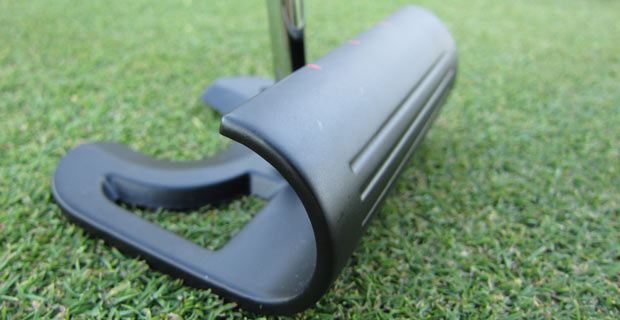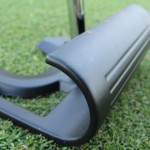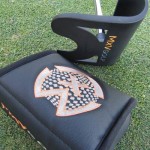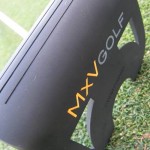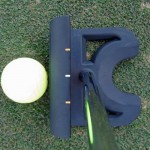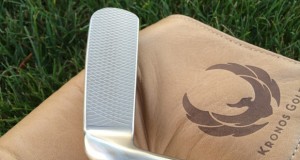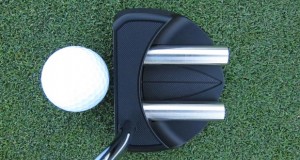Every so often a putter comes along that thinks differently—and the latest example is the new MxV1 mallet by MxV Golf.
The MxV1 putter was invented by entrepreneur Brian Wittman, and was inspired by Newton’s Cradle, a popular desk toy that demonstrates the conservation of momentum, or “mass x velocity”—hence the name MxV Golf.
The result is a putter that, like Newton’s Cradle, aims to strike the ball with another “ball” in the form of a rounded face in order to achieve a perfect roll. Does the MxV1 ($199) putter deliver the goods? Following is PutterZone’s MxV1 putter review.
The Storyline
The defining feature of the MxV1 putter is called Center Strike Technology, which consists of a ball-shaped face that is the exact diameter of a regulation golf ball, enabling the golfer to strike the center of gravity with each putt.
“Striking an object’s center of gravity with an object of the same shape is more consistent and more easily achieved than striking an object with an opposing shape,” Wittman says. The result is “true roll and no backspin, all with increased accuracy.”
To use the putter, MxV Golf advises that the golfer employ a “sole, press and sweep” stroke method. This means that you sole the putter behind the ball, lean the shaft slightly toward the target (which is called a forward press), and then sweep the putter low and through the ball with a pendulum swing.
Says Wittman, “Essentially you’re hitting a ball with a ball. In order to engage Center Strike Technology, a slight forward press and sweeping of the ball is essential. A slight forward press with a modified pendulum swing with emphasis on the forward stroke (ie: shorter backswing) is a proven, successful putting technique.”
He adds, “If you visualize Newton’s Cradle and the arc that the outside ball has as it approaches the target ball—we are mirroring that behavior. And as a result, we are striking the center of gravity every time and achieving a true roll for unparalleled accuracy. You’ll find that no matter how you approach the ball (so long as you sole the club and sweep) you’ll achieve a true roll, even if you are off center on the alignment of the putter face.
The stainless steel head of the MxV1 putter is a heavy 420 grams “to promote a pendulum swing.” The standard lie angle of the MxV1 is 70 degrees, although it is available in 68 through 72 degrees when purchased directly from MxV Golf. The putter is stroke balanced, a rare configuration that is neither face balanced nor toe hung. With a stroke-balanced putter, the face remains perpendicular to the ground when balanced on your finger, with the face pointing in the direction of the stroke.
The View from PutterZone
I was pleasantly surprised when I first got my hands on the MxV1 putter. In the promotional photos, it tends to look exotic, if not eccentric, with its tubular profile. But when you stand over your putt, it suddenly comes into harmonious focus, and actually looks quite clean and linear.
When struck correctly, the MxV1 initiates a clean, crisp roll on the ball as advertised. I play and practice in a dry climate with greens that tend to be hard and fast, and on these surfaces, the MxV1 delivers a tight topspin that is fun to behold.
In using the MxV1, the advantage of the “sole, press and sweep” method becomes quickly apparent. This stroke method keeps the putter face moving low and directly through the ball for the “ball on ball” effect. If you hit the ball on a slight upstroke with the MxV1, it seems to create a sort of pinching effect that bounces the ball at impact.
Research by one of the big golf companies has indicated that most golfers strike the ball with the sole of the putter about 3/10 of an inch above the ground at impact. You don’t want to do this with the MxV1 putter. You want to keep the sole low through impact to create the “ball on ball” effect.
Toward that end, the “sole, press and sweep” method may sound more involved than it really is. It really just comes down to leaning the shaft slightly toward the target, then keeping the putter low through the stroke.
Using a forward press ultimately comes down to personal preference. In fact, the MxV1 might help some golfers discover the forward press as a beneficial addition to their stroke mechanics. But if it’s not something you’re prepared to do, then at least the MxV1 is up front about it.
Meanwhile, I would characterize the feel (both tactile and audio) of the MxV1 putter as firm and slightly abrupt, with a bit of ring that seems to emanate from the tubular shape. I would like more suppleness in the feel, but I’m not sure that’s possible given the design of the putter.
A surprising standout feature of the MxV1 is the clear view of the face provided at setup. With the MxV1 putter, the shaft enters the middle of the head, providing a full unobstructed view of the topline and face (see fourth photo in gallery above), making it very easy to focus on squaring the face angle to the target line. This is particularly helpful when employing the recommended forward press, to make sure you don’t accidentally un-square the face when leaning the shaft forward.
Another fun discovery is the fact that the circular alignment cutout in the rear flange doubles as a nifty ball picker-upper. With a swift yet gentle sweep, the ball picks right up and stays in its place.
The 420-gram head sounds really heavy on paper, but it doesn’t feel too heavy in the hands. There’s a nice overall balance to the swing of the MxV1 putter, and it seems to offer unusual stability on off-center strikes.
The MxV1 putter comes with a branded Argyle Comfort mid-sized grip and a nice magnetic-closure embroidered headcover that befits the putter’s price point.
The Bottom Line
The MxV1 putter defies convention in pursuit of a better roll. When the recommended “sole, press and sweep” stroke is employed, the MxV1 delivers a clean, tight topspin that is a joy to behold. The heavier head, stroke-balanced configuration and clean profile at setup combine to offer the golfer a compelling alternative to getting the job done on the green, as long as he or she is prepared to commit to the recommended stroke.
 PutterZone – Best Putter Reviews
PutterZone – Best Putter Reviews
